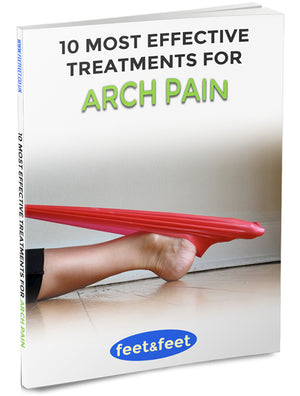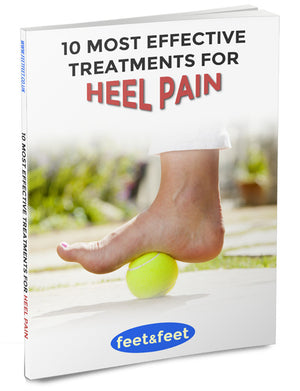5 Best Methods to Relieve Pain in the Heel of the Foot

Life was so simple; daily routines and activities were not a problem.
Then one day you felt a slight discomfort in your feet, but not enough for you to do anything about it.
I mean, it could have just been the new shoes that you really wanted; whether they were comfortable enough was not an issue.
Now further down the line you have constant pain in the heel of the foot, and searching for an answer of why your pain has not gone away. Heel pain can get sore to the point where you have no choice but to rest.
If you have left the pain for too long, in some cases surgery is the only way to resolve your condition.
Thankfully, there are ways to help improve your condition and heal the pain before it gets too serious. Here are our 5 best methods to relieve pain in the heel of the foot.
1. Remember to Put Your Feet Up
We mean this literally and metaphorically...
It’s all too easy to put too much pressure for too long on your heels. Standing for hours at a time if you work in retail, going out for a run every other day or even walking long distances can affect your heels negatively (especially if you wear the wrong type of footwear).
In these instances, you need to make time to relax your feet; whether during your lunch break or at the end of the evening.
It’s a good idea to put your feet up on a foot rest or on a stack of pillows if you’re laying down because elevation of the feet helps blood flow to travel from your feet back to your heart. This relieves tired, swollen and painful feet.
2. Regular Stretching
Regular stretching of the Plantar Fascia (the tissue that connects your heel bone to your toes) will loosen and flex the ligament.
Some effective ways to stretch and loosen your feet are:
Rolling Your Feet
One of the easiest and most satisfying ways of easing foot pain is be rolling your feet over a well designed foot roller massager. The hard and uniform points and ridges of the rollers work in harmony to stretch the muscles in the sole of your feet consistantly. Making a habit of using a foot roller for 10-20 minutes everyday can work wonders for relieving foot pain and increasing foot strength.

Plantar Fasciitis Toe Stretch
- Gently pull back on your toes until you feel tension on your heel
- Apply pressure with your thumb with the opposite hand to the sole of your foot
- Rub thoroughly with a back and forth motion from bottom to top between 3-5 minutes on each foot
There are a few different stretches and exercises to help stretch and ease pain of the plantar fascia. We recommend you to grab a copy of our free report “5 Effective Exercises to Relieve Foot Pain” to learn more.
3. Applying an Ice Pack
Ice therapy is a popular treatment for athletes when they want a quick recovery after an intense workout or if they’ve sustained an injury.
There are various specially designed ice packs for the feet which either wraps around the entire foot or is simply placed beneath the foot – both serve the purpose of reducing pain, swelling and inflammation.
It’s generally recommended to use an ice pack for 15-20 minutes at a time, after which you have to allow 40-45 minutes for the skin to re-warm before the application of an ice pack again.
Please Note: Do not place the ice pack directly onto the skin unless directed by manufacturer. Also, if you have sensitive skin, then consult a doctor before using an ice pack.
4. Wearing Supportive Footwear
You should always make sure you are comfortable within your shoes (yes, even at the expense of style!) and be particularly careful when selecting shoes with leather as they tend to have less give in the fabric.
Heel cups and cushions and contoured insoles offer excellent support as they help cushion the impact and pressure on your heels that come with walking, running and jumping.
The best possible footwear would be a pair of well engineered running trainers as they are specifically designed to help decrease the impact on the heel – something that is vital to all types of sports people.
5. Medical Drugs
At Feet&Feet, we would always recommend you to apply natural methods of foot pain relief above anything else.
However, there are some cases where sufferers of foot pain have put off treatment for so long until the point where the pain may be too unbearable, which makes daily tasks practically impossible.
If you’re stuck in this situation, you may want to ease the pain by using non-steroidal anti-inflammatory drugs such as Ibuprofen. You can read more about different types of medications to treat foot pain here.
Why You Are Experiencing Heel Pain
One of the major causes of heel pain is a condition called Plantar Fasciitis, which accounts for 4 out of 5 cases.
Other less common causes are:
- Bone Spurs;
- Sever’s Disease
- Tarsul Tunnel Syndrome
- Fat Pad Atrophy
- Stress Fracture
- Being Overweight (a higher body mass puts more pressure and impact on the heels)
What is Plantar Fasciitis?
Plantar Fascia is a thick band of tissue that is jointed between the heel bone to the rest of the foot. Plantar Fasciitis is the medical term used where the tissue that connects the heel bone to the toes becomes damaged and thickens.

Reasons for this condition occuring could be down to:
- Wear and tear of the tissues. This would generally apply to adults aged 40 and over.
- Spontaneous Damage as a result of any physical activity that puts constant pressure on the heel, particularly gymnastics, running, jogging and dancing.
When effective treatment is applied, 4 out of 5 cases of heel pain are usually resolved within one year. The above methods and our foot roller massagers are designed to help relieve and resolve the pain and frustration throughout your condition period.
1 out of 20 reported cases of heel pain are untreatable with simple and cost effective methods such as the one’s mentioned in this article. In these situations, surgery will likely be needed to release the plantar fascia.
If your heel pain has arrived at the point where the pain is constant and unbearable, then we recommend that you see a doctor or foot specialist to see what alternative methods of treatments are available.
Infographic
We've created an infographic for our "5 Best Methods to Relieve Heel Pain". Feel free to share it on social media or on your website/blog but please provide a backlink to this article and cite Feet&Feet as the source.

To enlarge the above infographic, right-click on the image and click "View Image".






Comments
Leave a comment